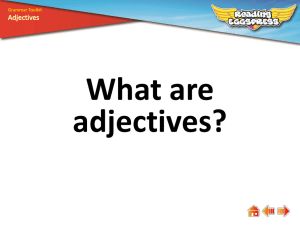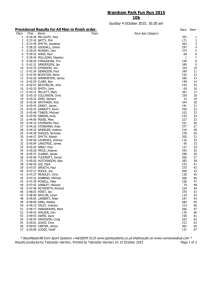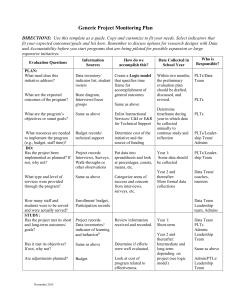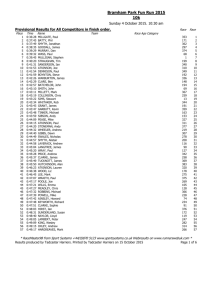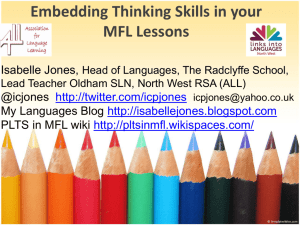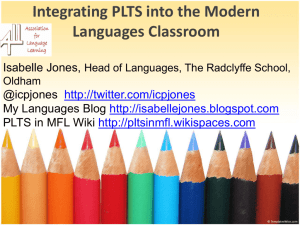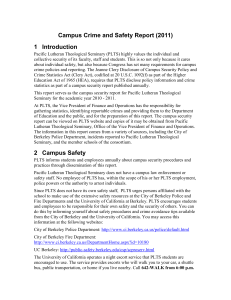Case Study/Article template and guidelines
advertisement
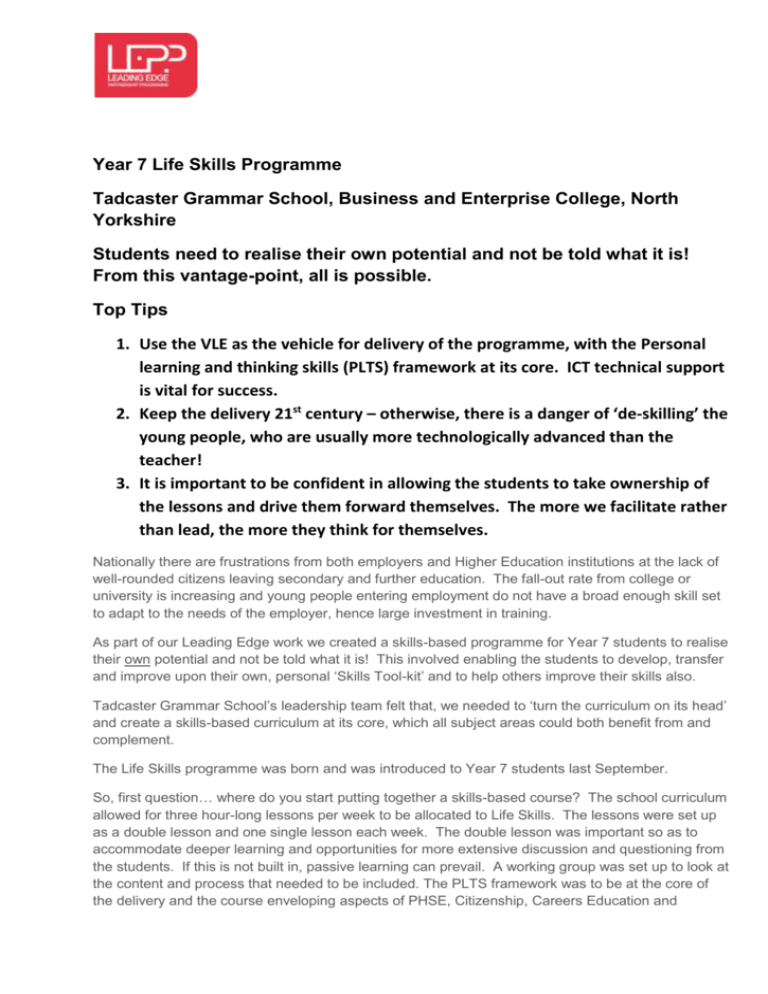
Year 7 Life Skills Programme Tadcaster Grammar School, Business and Enterprise College, North Yorkshire Students need to realise their own potential and not be told what it is! From this vantage-point, all is possible. Top Tips 1. Use the VLE as the vehicle for delivery of the programme, with the Personal learning and thinking skills (PLTS) framework at its core. ICT technical support is vital for success. 2. Keep the delivery 21st century – otherwise, there is a danger of ‘de-skilling’ the young people, who are usually more technologically advanced than the teacher! 3. It is important to be confident in allowing the students to take ownership of the lessons and drive them forward themselves. The more we facilitate rather than lead, the more they think for themselves. Nationally there are frustrations from both employers and Higher Education institutions at the lack of well-rounded citizens leaving secondary and further education. The fall-out rate from college or university is increasing and young people entering employment do not have a broad enough skill set to adapt to the needs of the employer, hence large investment in training. As part of our Leading Edge work we created a skills-based programme for Year 7 students to realise their own potential and not be told what it is! This involved enabling the students to develop, transfer and improve upon their own, personal ‘Skills Tool-kit’ and to help others improve their skills also. Tadcaster Grammar School’s leadership team felt that, we needed to ‘turn the curriculum on its head’ and create a skills-based curriculum at its core, which all subject areas could both benefit from and complement. The Life Skills programme was born and was introduced to Year 7 students last September. So, first question… where do you start putting together a skills-based course? The school curriculum allowed for three hour-long lessons per week to be allocated to Life Skills. The lessons were set up as a double lesson and one single lesson each week. The double lesson was important so as to accommodate deeper learning and opportunities for more extensive discussion and questioning from the students. If this is not built in, passive learning can prevail. A working group was set up to look at the content and process that needed to be included. The PLTS framework was to be at the core of the delivery and the course enveloping aspects of PHSE, Citizenship, Careers Education and Guidance and Enterprise Capability. Alongside these national curriculum requirements, sat the Every Child Matters criteria. The course needed to be underpinned by a model of Assessment for Learning, which would highlight and track student progress over the year in all key areas. This was a challenge! For the sake of the students and staff delivering the course, with its multi-faceted content, it was decided that ‘less is more’. Two models for assessment were created: Toolkit Tasks were set up to focus on the PLTS criteria, with one of the six skills being assessed each half term. The Toolkit Task would be based on four distinct outcomes: What has the student shown in relation to the skill? How has the student participated in the task set? Where has the student used that skill elsewhere in and out of school and how would that student seek to improve upon that skill? The second model of assessment was created as a more robust, in-depth, project-based assessment focusing on citizenship participation and PHSE requirements. There is an abundance of material that can be covered but the students need distinct guidelines with respect to what is being assessed and developed within their Skills Toolkit. How do you start such a course? Its strength had to lie in its relevance to the students so that they took ownership for their own learning and development. Far too often, as practitioners, we field the complacency and blame culture within society… after-all, a school reflects all walks of life! These young people, from the moment they enter our gates, must feel empowered and trusted to make decisions, take risks where necessary and map out their own futures with our help and guidance. The other element that must not be under-estimated is that of the worries held by the Year 6 students and their parents as they make that substantial move from primary to secondary education. We launched the course with the students in relation to taking part in their educational journey as a citizen of Tadcaster Grammar School. It was relevant to start the course by looking at the cross-curricular dimensions of Identity and Community Participation. We focused on ‘Who Am I and How do I Learn?, building in ‘Learn2Learn’ materials and ‘Philosophy 4 Children’ processes. After their first term we covered Enterprise activities and Careers Education, finishing off in the third term with Healthy Lifestyles and issues surrounding puberty. All content was built around many pair & share or group work activities, which is highly interactive. The VLE was the anchor for delivery and assessment, with teachers marking the Toolkit tasks and Assessments on-line. ICT extension activities were built in to a single lesson every other week. It became very apparent that students really embraced this 21st century approach. On many occasions, students would thank staff for their ‘emailed’ feedback about their homework! PLTS criteria were met. Students embraced the interactive, mature approach to their learning. They enjoyed questioning their own ideas and perceptions of topics discussed and appreciated being listened to. We are currently working with Sherburn High School, who want to introduce a similar course on their VLE and support and guidance from our staff has been built in under the Collaborative Partnership remit. Other schools and FE colleges have visited to find out more about the course and have felt inspired to rejuvenate their own Skills and Personal Development programmes of study. The current Year 7 course is being reviewed and a new course is under development to roll out to Year 8 students in September 2010. The Year 9 programme will then be created and so on. More collaboration with partner schools is envisaged and consultancy provided. School name Tadcaster Grammar School LA North Yorkshire County Council Specialism (if any) Business and Enterprise College/Leading Edge Context of school 11-18, Secondary with 6th form, mixed sex Contact name at school for the article/case study and resources Amanda Henson, Head of department, Leading Edge Contact a.henson@tadcaster.n-yorks.sch.uk 01937 837650

